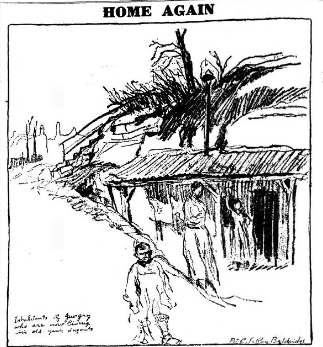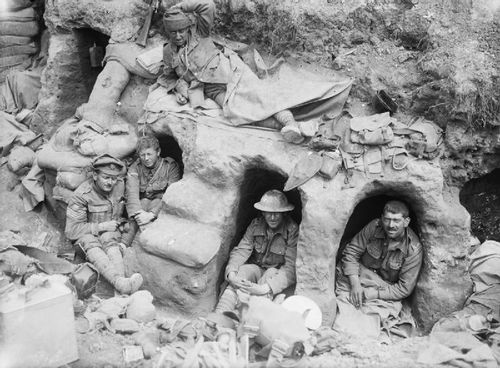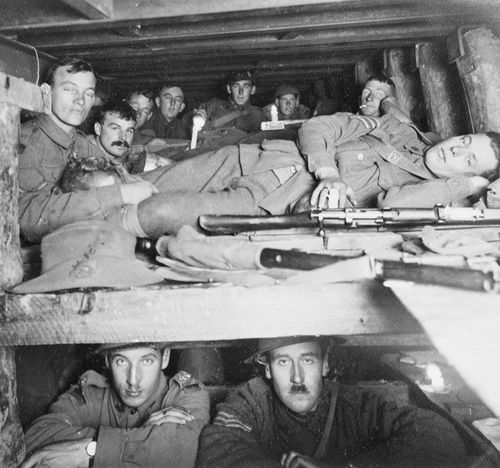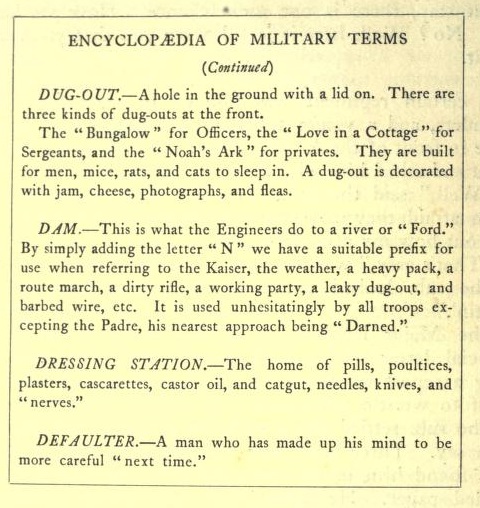JF Ptak Science Books Post 2569
I came across this field drawing in the September 21, 1919 issue of Stars and Stripes. It is called "Home Again", and depicts the conditions of the homeless in post-WWI Europe...unfortunately I cannot decipher the name of the town, though I suspect it is either Belgian or French (not too much of a leap of faith with that). For the dozens of millions of casualties in WWI, there were also many millions of people left destitute and homeless. This small illustration shows one case, the residents of this town forced to take shelter in the dugouts1 (see below for the OED definitions and history of the word) of an old U.S. Army trench.
Dugouts are more-or-less what the name implies, a shelter dug into the side of a trench to offer cover from shrapnel and the elements; these could be a hidey-hole the size of a soldier, or could be larger to house several soldiers at a time, though in general they were small, cramped affairs, meant to be sat rather than stood in. The design was also governed by the amount of trench depth that you had to work with. Sometimes the dugout would be attached to a tunnel leading deep under the trenches that would house headquarters and such and accompany man more men than the usual occupancy of, say, 1-4 soldiers. These seem to be more expansive than normal, being fully the height of a person, with more enclosure, and an awning.
This strikes me as a particularly difficult image of the post-war situation

The following images are found at the Imperial War Museum, here: http://www.iwm.org.uk/history/podcasts/voices-of-the-first-world-war/podcast-20-trench-life
A simple dugout, no doubt fashioned in necessity according to what was available:

Here's an example of a more deeply dug dugout ("fifteen feet underground"):

Also, via a find by Public Domain Review, this 1916 soldier's definition of "dugout":
Source: http://publicdomainreview.org/collections/made-in-the-trenches-a-ww1-magazine-created-by-soldiers-1916/ Original source: Made in the Trenches, composed entirely from articles & sketches contributed by soldiers, edited by Sir Frederick Treves and George Goodchild; 1916; George Allen and Unwin , London.

Notes:
1. The etymology of "dugout", via the Oxford English Dictionary:
dug-out, adj. and n.
Hollowed out by digging, excavated.
1886
Athenæum 24 Apr. 556/3 In some cases the station was completely insulated, and reached only by means of dug-out canoes.
1887
Archaeologia 50 370 Dug-out boats of more or less rude construction.
1889
Spectator 14 Dec. 838 Ordinary dug-out canals like that of Suez.
1. A canoe made by hollowing out the trunk of a tree.
1819 J. A. Quitman in Clairborne
Life (1860) I. 42 At Wheeling..we purchased a small canoe, called here a ‘dug-out’, or ‘man-drowner’.
1839 F. Marryat
Diary in Amer. II. 57 We had no boat with us, not even a dug-out.
1887
Archaeologia 50 370 Ship-building..of a very superior kind to these rude dug-outs.
a. A channel made by digging. U.S.
1854 J. R. Bartlett
Pers. Narr. Explor. Texas II. xlv. 535 A little further we came to a ‘dug out’—that is, a passage cut or dug across a bar.
b. A rough kind of dwelling formed by an excavation in the ground (usually in a slope or bank), roofed with turf, canvas, etc. Also attrib.
1855 in J. A. Thomson
80 Years Reminisc. (1904) I. 171, I live in a dug-out tent [at Balaklava], which is pretty warm, with a capital fire-place made out of potato tins!
1860
Jrnl. Discourses 8 293/1 When you have built splendid habitations, be as willing to leave them as you would to leave a dug-out.
1873 J. H. Beadle
Undeveloped West xxxi. 685 The unhappy traveler, if compelled to seek shelter in winter, will find it in a Swedish ‘dug-out’.
1881
Chicago Times 16 Apr. Instead of ‘dug-outs’ on the prairies, he found the farmers living in large, handsome frame houses.
1883
Leisure Hour 281/2 The Kansas ‘dug-outs’ consist..of a square hole dug in the ground, roofed either by a canvas waggon-cloth or..with sods.
c. spec. Applied to the roofed shelters used in trench warfare. Also attrib.
1904
Westm. Gaz. 7 Dec. 7/1 The following telegram from General Sakharoff..has been received at St. Petersburg:..Our troops, thanks to their dug-outs, warm clothing, and plentiful food, do not suffer from the cold.
1914 D. O. Barnett
Let. in
In Happy Memory (1915) 19 A dug-out in the reserve trenches.
a1917 E. A. Mackintosh
War, the Liberator (1918) 23 And I shall see no more The gallant friendly faces Framed in my dug-out door.
1919 G. K. Rose
2/4th Oxf. & Bucks Light Infantry 26 Desire Trench..was a shallow disconnected trough upholstered in mud and possessing four or five unfinished dug-out shafts.







Comments